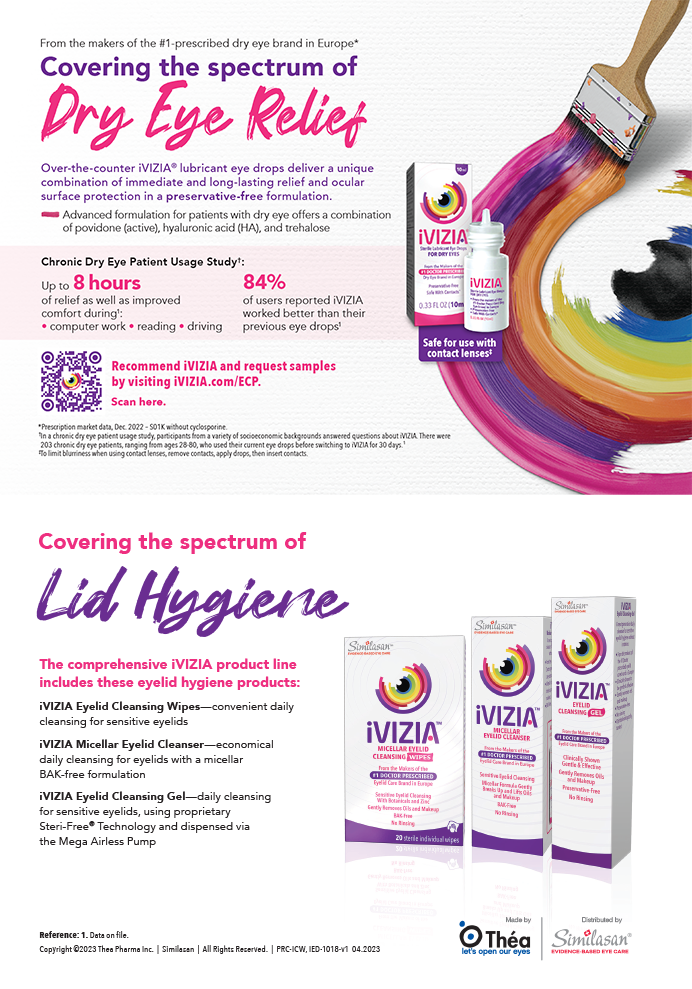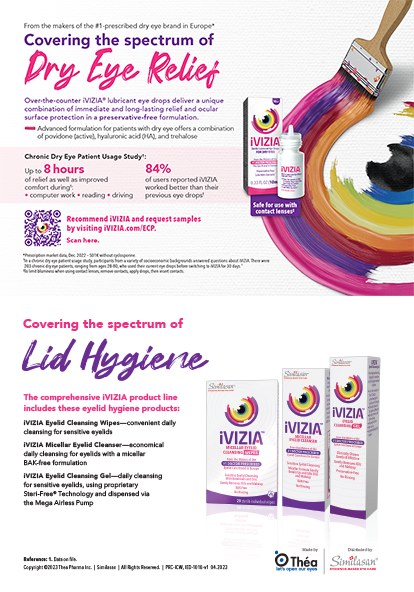Cover Stories | Nov 2005
The Infiniti Vision System
Key design elements for safety include a reduced risk of thermal injury, pressure infusion monitoring, and a torsional ultrasonic handpiece.
Richard J. Mackool, MD
A Safe phacoemulsification depends on a three-pronged strategy: (1) effective chamber maintenance; (2) consistent thermal protection; and
(3) the less turbulent flow of fluid through the eye. Several design features enable the Infiniti Vision System (Alcon Laboratories, Inc., Fort Worth, TX) to meet those goals in even the toughest case.
The system lessens the risk of thermal injury by several means, including a flared, dual-sleeved, ultrasonic tip that protects the chamber by reducing surge and increasing infusion capacity. The tip's microbore shaft enlarges infusion capacity, because the space between the inside of the infusion sleeve and the outside of the ultrasonic needle allows additional fluid to enter the eye. The flared tip of my design has a low coefficient-of-friction polymer sleeve and is called the Mackool Tip (Alcon Laboratories, Inc.). This sleeve maintains the chamber's depth by permitting the use of small incisions to prevent leakage through the phaco incision. In addition, these features reduce turbulent flow inside the eye. The flared Mackool Tip greatly lessens the chances of burning the incision by decreasing friction between the vibrating needle and the surrounding infusion sleeve and incision.
THERMAL ADVANTAGES
In two studies, thermal imaging of the ultrasonic tip performed in air and in human cadaveric eyes demonstrated the least temperature elevation for the Infiniti/Series 20000 Legacy Cataract System (Alcon Laboratories, Inc).1,2 Additionally, the Infiniti features the Aspiration Bypass System, which is actually a small hole along the distal side of the needle that permits a cooling flow through the port at all times. Even when the phaco tip is occluded, the Aspiration Bypass System allows a small amount of fluid to flow through the tip during the entire time that the needle is inside the eye.
INFUSION PRESSURE SENSOR
The Infiniti's unique Infusion Pressure Sensor monitors pressure in the infusion line. It delivers a warning signal and stops the pump and ultrasonic system if one of several predicaments occurs. For example, if the infusion bottle runs out of fluid, or the infusion line becomes crimped or compressed, the sensor recognizes that the system's capacity to deliver fluid to the eye may be compromised. It emits a warning sound and deactivates the pump, which stops the system.
The Infusion Pressure Sensor has enabled me to avert disaster on several occasions. When a handpiece is aspirating about 40mL/min from an eye, the chamber volume of which is at the very most about 0.25mL/min, it will take less than a second to collapse the chamber if infusion fluid is unavailable—a risk that makes the Infusion Pressure Sensor invaluable.
NEOSONIX HANDPIECE
The Neosonix handpiece can be set to vibrate as soon as ultrasound is activated. The surgeon feels the oscillation and knows immediately whenever the foot pedal is in position three. This information is beneficial because most surgeons do not really know that they are applying ultrasound until they begin to hear cavitation in the hub of the needle; by then, they are frequently using as much as 30% power. With the Neosonix handpiece, I know immediately that I am applying ultrasound because I can feel the vibration.
Moreover, the handpiece functions like a third hand by constantly repositioning lenticular material on the tip with less “skewering” or coring of the nuclear tissue. This function is particularly helpful for dense nuclear segments, because, in these cases, the ultrasonic tip tends to impale the lenticular material and thus force surgeons to reposition it with a second instrument such as a spatula. The problem is that this instrument should be kept in a position that is posterior to the phaco tip in order to protect the posterior capsule during the aspiration of the nucleus (eg, in case of infusion misdirection that pushes the posterior capsule forward).
TORSIONAL ULTRASONIC HANDPIECE
Another of the system's safety benefits that I have enjoyed and that will be widely available soon is the optional torsional ultrasonic handpiece. Instead of functioning in a linear motion like a conventional phaco handpiece, the torsional handpiece oscillates 32,000 times per second. In addition to removing lenticular material with extreme efficiency, the handpiece completely eliminates chattering and provides thermal benefits. A comparison of oscillating and linear phacoemulsification illustrates that oscillation of an angulated phaco tip delivers increased energy to the tip where an incisional burn is not a concern. In contrast, with linear ultrasound, the same amount of energy exists on the portion of the shaft within the incision as on the tip. The amount of heat created with the torsional ultrasonic handpiece is approximately 35% of that created using conventional ultrasound, but the delivery of energy to the nucleus is comparable.
The benefits of torsional phacoemulsification are most obvious in difficult cases. I recently operated on a patient who had an endothelial cell count of 400, a dense nucleus, and a shallow chamber. With torsional phacoemulsification, I used a fraction of the energy that would otherwise have been necessary, and there was no chattering of lenticular particles. One day postoperatively, the cornea looked crystal clear.
The Infiniti's fluidics provide further control and safety by allowing the use of extremely high flow and vacuum levels. I employ vacuum settings as high as 750mmHg. When a handpiece is holding particles that tightly to the tip, every burst of ultrasound removes much more material, because the energy is transmitted directly to the nucleus. The ability to use these parameters to attract, hold, and remove lenticular material, in combination with all of the other safety features, leaves me literally in awe of the Infiniti Vision System.
CONCLUSION
Thermal protection (Mackool Tip, Aspiration Bypass System, torsional handpiece) and the efficient delivery of energy to the nucleus are benefits of the Infiniti Vision System that increase the safety and effectiveness of phacoemulsification. These benefits are also enhanced by Neosonix oscillations and the surgeon's ability to use a wide range of fluidic parameters. Finally, the Infusion Pressure Monitor of the Infiniti acts as a sentry for adequate infusion capacity.
Richard J. Mackool, MD, is Director of the Mackool Eye Institute and Laser Center in Astoria, New York. He is a consultant to Alcon Laboratories, Inc., but states that he holds no financial interest in the products mentioned herein. Dr. Mackool may be reached at (718) 728-3400 ext. 256; mackooleye@aol.com.
1. Mackool RJ, Sirota MA. Thermal comparison of the Advantec Legacy, Sovereign Whitestar, and Millennium phacoemulsification systems. J Cataract Refract Surg. 2005;31:812-817.
2. Olson MD, Miller KM. In-air thermal imaging comparison of Legacy Advantec, Millennium, and Sovereign Whitestar phacoemulsification systems. J Cataract Refract Surg. 2005;31:1640-647.


